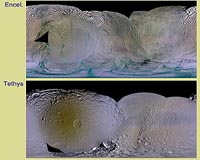 |
Louisville KY (SPX) Oct 07, 2009 Saturn is rotating five minutes faster than previously thought, a fact that sheds new light on the planet's composition. Wave patterns in Saturn's clouds show that scientists have been using the wrong rotation rate for the planet, said Timothy Dowling, a planetary atmospheres researcher at the University of Louisville, who helped make the discovery. The work by Dowling and his colleagues solves a long-standing puzzle regarding Saturn's winds and also offers clues to the planet's deep interior. All of the gas giants - Saturn, Jupiter, Uranus and Neptune - spin on their axes with well-defined rotation periods, just like the rocky planets. But with no solid surface features to track, measuring how long they take to make a complete spin has been a challenge. "Saturn is the second-largest planet in our solar system, but we've never known the length of its day," Dowling said. "It's like trying to listen to recorded music without knowing what speed to play the tape." Researchers have successfully measured the rotation of Jupiter, Uranus, and Neptune because all of those planets have tilted magnetic fields that swivel like a lighthouse beacon. Saturn's magnetic field, however, is pointed straight up and down, making it impossible to see its spin. Until now, scientists have used an imprecise yardstick to measure Saturn's rotation: weak radio signals. But even NASA's Cassini probe, a spacecraft launched in 2004 to study Saturn and its moons that revealed methane lakes on Titan, could not determine exactly how fast Saturn was turning. When scientists compared data gathered by Cassini to data gathered in the early 1980s by the Voyager probe, the numbers showed a significant change in the planet's rotation rate. "We knew that couldn't be right because planets just don't speed up and slow down in a few years' time," Dowling said. Dowling previously had tracked large waves on Jupiter in a breakthrough finding that offered new clues to the atmosphere beneath the Jovian clouds. He and his colleagues were scrutinizing Saturn's wind patterns when they noticed similar large waves there. "The waves were standing still, sort of like a swimmer who heads upstream and just keeps up with the current," he said. Using detailed temperature data collected by Cassini, the researchers developed a three-dimensional computer model of Saturn's waves. After allowing for wind drift, they found that the planet's day was 10 hours, 34 minutes, 13 seconds long - or five minutes shorter than previously thought. This makes Saturn have both eastward and westward jet streams, making it appear much more like Jupiter than previously thought. The finding also offers new insight on Saturn's density and interior structure, since the faster a planet spins the more concentrated its center needs to be to maintain its planetary shape. Peter Read, a University of Oxford physicist and member of the Cassini team, and Gerald Schubert and Ravit Helled, geophysicists from the University of California, Los Angeles, and experts on Saturn's interior, joined Dowling on the project. Share This Article With Planet Earth
Related Links University of Louisville Explore The Ring World of Saturn and her moons Jupiter and its Moons The million outer planets of a star called Sol News Flash at Mercury
 Particles Discolor Saturn's Inner Icy Moons
Particles Discolor Saturn's Inner Icy MoonsHouston TX (SPX) Oct 06, 2009 New global color maps reveal provocative patterns on the surfaces of Saturn's five innermost large icy satellites: Mimas, Enceladus, Tethys, Dione, and Rhea. These new maps are being presented in a report by Dr. Paul Schenk of Houston's Lunar and Planetary Institute at the AAS Division for Planetary Sciences meeting in Puerto Rico. The new maps reveal complex global color patterns on each ... read more |
|
| The content herein, unless otherwise known to be public domain, are Copyright 1995-2009 - SpaceDaily. AFP and UPI Wire Stories are copyright Agence France-Presse and United Press International. ESA Portal Reports are copyright European Space Agency. All NASA sourced material is public domain. Additional copyrights may apply in whole or part to other bona fide parties. Advertising does not imply endorsement,agreement or approval of any opinions, statements or information provided by SpaceDaily on any Web page published or hosted by SpaceDaily. Privacy Statement |